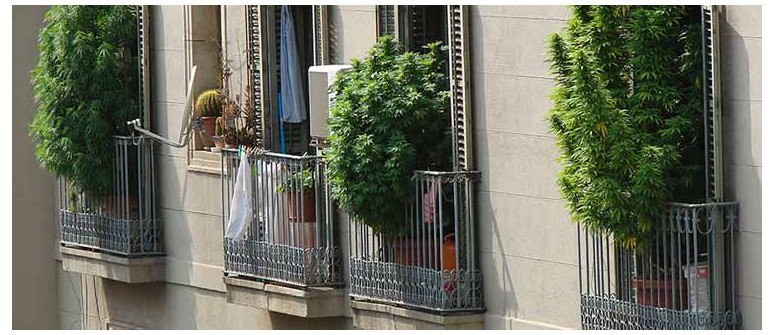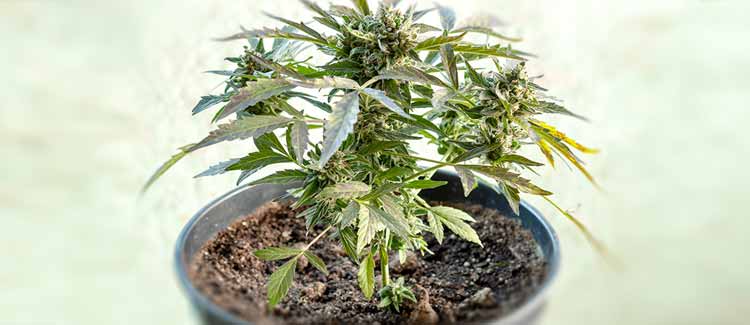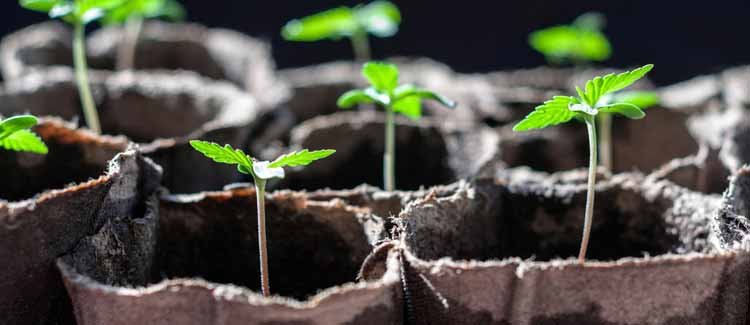7 tips for growing great weed on your balcony or terrace

Ever pondered the idea of growing cannabis on your small balcony or terrace? Well, it's totally possible. Even the smallest inner-city balconies can house a cannabis plant. All you need is plenty of sunlight and some time to dedicate to your plant, and she'll reward you with some delicious flowers in no time!
Most grow articles target either growers with a big outdoor garden and plenty of space, or those with a solid indoor setup. But even if you only have a small balcony or terrace with plenty of sunlight, you’ll be harvesting your own buds in no time.
Here are 7 tips to help get your balcony grow-op started.
1. PICK THE RIGHT POT
When growing weed on a balcony or terrace, you’ll be growing them in some kind of pot or container. It depends a bit on your preferences and skills as a grower, but all you really need is a standard flower pot with drainage holes and a saucer to catch any excess water.
Far more important than the type of container, is the size of said container. After all, the size of the pot will directly impact the size of your plants.
Smaller pots will provide less room for your plant’s roots and will thereby restrict their growth. Larger pots, on the other hand, will provide more room and usually lead to larger plants.
Know your space and choose accordingly. Keep in mind the legality of Cannabis while choosing a terrace spot, as much as we can be proud of our plants, it might now be a good idea to show them to the worlds.
2. PICK THE RIGHT GENETICS

It is important to know that in general, sativa plants grow bigger in size than indica plants. If you have a smaller space and want to keep your plants small, an indica would be the way to go.
Indica’s also do better with less light. So this might be something to keep in mind if your balcony is not facing south.
Another good option would be to grow autoflowering strains. thanks to their ruderalis genetics, autoflowering strains tend to grow slightly smaller than regular cannabis strains, but also don’t require strict light/dark periods in order to flourish and flower like regular strains.
Because these strains flower based on their age, they’re not as sensitive to changes or interruptions to their light cycle, which makes them ideal for a balcony with less light and even colder climates.
3. PICK THE RIGHT SPOT
Once you’ve picked your strains and have the right size container, it’s time to think about where your baby is going to grow. Remember, unless you plan to grow autoflowering strains, cannabis plants need plenty of light during the day, followed by complete darkness during the night.
Ideally, you’ll want your plant to receive at least 5–6 hours of direct sunlight during the day, preferably during the morning or late afternoon (depending on where you live, the midday sun may be too harsh even for your hardy cannabis plant).
You’ll also want to make sure you position your plants somewhere well-protected from strong winds or rains. The good thing about growing in containers is that they’re usually easy to move around.
South (or slightly southeast) facing balconies/terraces tend to be ideal for most plants as they usually get direct sunlight in the morning, followed by indirect light during midday/late afternoon. Obviously, you can’t change the direction of your balcony/terrace, so just work with what you’ve got and remember to keep a close eye on your plant to ensure she’s getting enough sun.
4. INVEST IN HIGH-QUALITY SOIL
The easiest way to grow on a balcony or terrace is to use soil. And, since you likely won’t have the option to compost your own soil, you’ll want to make sure you buy the highest quality soil available to you.
Luckily, all you’ll need to create a great bed of soil for your cannabis should be available from your local gardening center. You’ll need:
- High-quality, preferably organic soil that drains well and is well-aerated
- Worm castings
- Some bat guano to top off your soil
- Fertilizer (cannabis-specific fertilizers are available at most grow shops)
- Rocks/stones for extra drainage
When it comes to choosing soil, try to opt for soils that are dark in color and have a loose, rich texture. High-quality soils will usually contain ingredients like composted forest humus, coco coir, perlite, worm castings, blood/fish/bone/crab meal, kelp, etc.
When it comes to planting, you’ll want to use 80% soil and roughly 20% worm castings. Mix the two together thoroughly to make a rich, loose grow medium. Then put down a layer of stones at the bottom of the pot, dump in your soil, and top it off with some bat guano and fertilizer.
5. START IN SPRING

When growing weed on your terrace, you’ll want to follow the same schedule as other outdoor growers. This means germinating and planting your seeds in spring.
In fact, you might want to start slightly earlier than other growers to give your plants a bit of extra time to grow and develop. Once your seedlings are in their pots, make sure to keep them in a nice, sunny spot. Indoors, seedlings don’t do well under strong grow lights, but outdoor seedlings can handle (and prefer) plenty of sunlight to get started.
By getting an early start in spring, you’ll ensure your plants have plenty of time to grow and develop throughout the warmer months. Then, by the end of summer/early autumn, they should be loaded with a nice collection of big, potent buds.
6. USE TRAINING METHODS TO KEEP YOUR PLANTS SMALL
After about 4 weeks of vegetative growth (for photoperiod strains), you’ll usually want to prune your plants in order to control and adapt their growth to the space you’re working in.
Most growers working on a balcony or terrace will want to keep their plants at low heights, encouraging them to grow “out” rather than “up.” To do this, you’ll want to trim a plant’s apex (or top sprout) down. This will encourage the plant to grow more leaves below the top sprout, essentially coaxing it to get bushier, rather than taller. You’ll want to continue trimming your plants regularly throughout the vegetative phase to control their growth.
There are also other ways such as tying or bending techniques (known as LST or low stress training) that allow you to direct your plants to grow in certain directions, and to make sure your plant’s canopy gets an equal amount of sunshine.
Other popular training techniques you may want to try with your terrace/balcony plants include topping, fimming, and supercropping. Each of them creating a different shape of canopy according to the growers individual needs.
7. DON’T LET YOUR PLANTS GROW SOLO

To create a rich microclimate for your plants, as well as keep them hidden from prying eyes, it’s a good idea to grow some other plants too.
Both leafy and flowering plants are a great addition to your cannabis garden. Plus, some plants can also help protect your weed from pests and disease by either repelling plants or inviting beneficial predators to the garden.
Some great companion plants to grow amidst your cannabis plants include:
- Basil
- Beans
- Garlic
- Mint
- Peppers
- Marigolds




